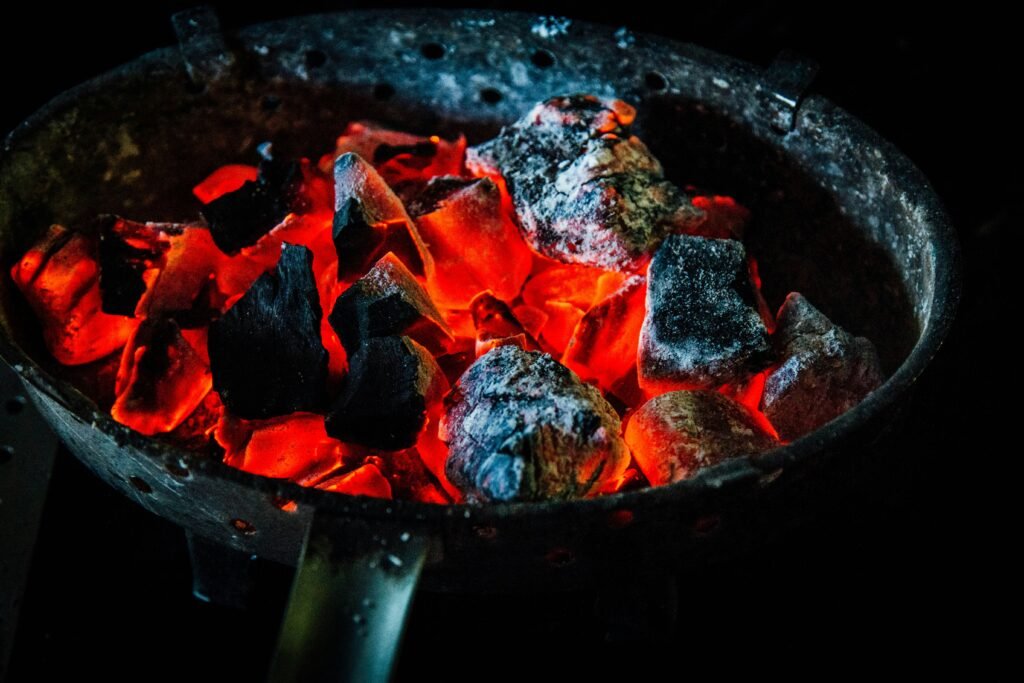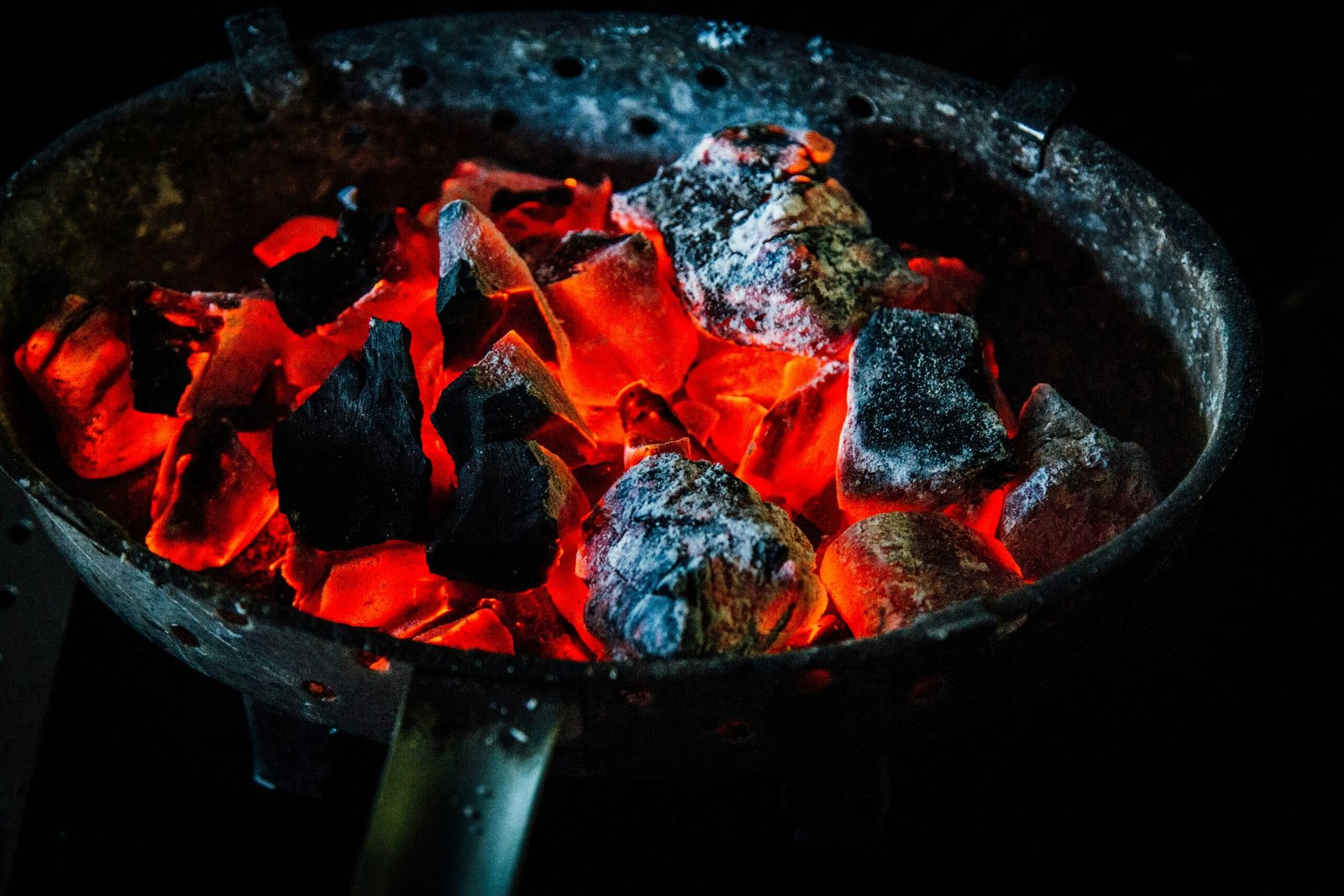If you’ve ever found yourself pondering the subtle distinctions between a barbeque grill and a griddle, you’re not alone. These two cooking appliances may seem similar, but they serve different purposes and offer unique cooking experiences. While both can satisfy your taste buds, understanding their differences will help you make an informed decision about which one best suits your culinary needs. So let’s fire up the grill and flip the griddle to discover the contrasts between them.

Definition
Barbeque Grill meaning
A barbeque grill, also known as a BBQ grill or simply a grill, refers to a cooking device used to cook food by applying direct heat from below. It typically consists of a metal grate or rack where the food is placed, and a heat source such as charcoal, gas, or electric elements. Grilling involves the process of searing food quickly at high temperatures, which gives it a distinct smoky flavor and charred appearance.
Griddle meaning
A griddle, on the other hand, is a cooking surface that is flat and smooth, usually made of cast iron, stainless steel, or non-stick materials. It is designed to evenly distribute heat across its surface, allowing for cooking at moderate to high temperatures. Unlike a grill, a griddle does not have an open flame or an elevated rack, making it ideal for cooking delicate foods or those that need to be cooked in their own juices.
Design and Structure
Design traits of Barbeque Grill
Barbeque grills come in various designs, ranging from portable and compact models to large, permanent installations in outdoor kitchens. They typically consist of a metal frame or body that houses the heat source and supports the cooking grate. The cooking grate is often made of stainless steel or cast iron for durability and heat retention. Grills may also have additional features such as adjustable racks, side tables, and temperature control mechanisms to enhance versatility and convenience.
Structure of a Griddle
Griddles, on the other hand, have a simpler structure. They are essentially a flat, solid surface that can be placed on top of a stovetop or built into countertops. The cooking surface of a griddle can either be completely flat or have raised ridges to create grill-like marks on the food. Griddles are typically made of materials such as cast iron or stainless steel, known for their excellent heat conductivity and durability.
Material comparison
Both barbeque grills and griddles can be made from various materials, each offering its own advantages. Barbeque grills often utilize stainless steel or cast iron for their cooking grates, as these materials are durable and retain heat efficiently. Griddles, on the other hand, commonly use cast iron or stainless steel for their cooking surfaces, ensuring even heat distribution and superior searing capabilities. The choice of material ultimately depends on personal preferences and cooking needs.
Mode of Cooking
Grilling in Barbeque grill
Grilling on a barbeque grill is all about direct heat. The food is placed directly on the cooking grate, where it gets seared and cooks quickly at high temperatures. The open flame and radiant heat from the coals or burners create those signature grill marks and impart a smoky flavor to the food. Grilling is ideal for foods like steaks, burgers, vegetables, and seafood, allowing them to retain their natural juices and develop caramelization.
Sauté or Fry in Griddle
When using a griddle, the cooking process is more similar to sautéing or frying. The flat, smooth surface of the griddle allows for even heat distribution, making it perfect for cooking items like pancakes, eggs, bacon, and thin cuts of meat. The absence of an open flame or grill grates ensures that the food remains tender and moist, with less risk of drying out. The even cooking surface also allows for better control over the cooking process, preventing uneven cooking or burning.
Heat distribution
One notable difference between a barbeque grill and a griddle is the way heat is distributed. In a grill, the heat is concentrated on the cooking grate, directly under the food. This creates a high-temperature zone that quickly sears the food and creates distinct grill marks. On a griddle, the entire surface area is evenly heated, providing consistent heat distribution across the cooking surface. This allows for more precise control over cooking times and ensures that food is cooked evenly.
Fuel Source
Fuel source for Barbeque Grill
Barbeque grills can be powered by various fuel sources, including charcoal, gas, and electricity. Charcoal grills are favored for their authentic smoky flavor but require more time and effort to light and manage the fire. Gas grills, on the other hand, offer convenience and precise temperature control, but may lack the smoky aroma associated with charcoal grilling. Electric grills are the most convenient option, as they can be used indoors and require minimal setup, but they may not deliver the same intense heat as traditional grilling methods.
Fuel source for Griddle
Griddles are typically powered by stovetops or built-in heating elements in electric or gas ranges. These provide a consistent, controlled heat source that is evenly distributed across the griddle surface. There is no need for additional fuel sources or ignition methods, making griddles a convenient option for indoor cooking. The choice between electric and gas griddles depends on personal preference and the availability of a suitable energy source.

Ease of Use
Usability of Barbeque Grill
Barbeque grills are generally user-friendly, offering straightforward operation. They often come with features that make grilling easier, such as temperature control knobs, ignition systems, and removable cooking grates for cleaning. While charcoal grills may require more attention and skill to manage the fire and achieve desired temperatures, gas and electric grills offer greater convenience and ease of use. It is important to follow proper safety guidelines and cooking instructions to ensure a successful grilling experience.
Usability of a Griddle
Griddles are also simple to use, providing a consistent cooking surface without the need for open flames or complicated temperature adjustments. They are ready to use as long as they are placed on a suitable heat source. The lack of grates and the flat surface make it easy to cook and flip delicate foods without worrying about them falling through gaps or sticking to surfaces. Operating a griddle is as easy as adjusting the heat settings on the stove or range and maintaining the desired temperature throughout the cooking process.
Learning curve comparison
In terms of the learning curve, both barbeque grills and griddles have their own considerations. Grilling on a barbeque grill may require some practice to control the heat and achieve desired cooking results. Learning to manage the fire, create different heat zones, and maintain proper grill temperatures may take time to master. On the other hand, using a griddle is relatively straightforward, as it mainly involves adjusting heat settings on the stove or range. However, achieving the perfect temperature for specific food items and mastering techniques like flipping and managing grease runoff may require some initial experimentation and experience.
Cleaning and Maintenance
Cleaning process for Barbeque Grill
The cleaning process for barbeque grills can vary depending on the type and design. However, common practices include removing leftover food debris from the cooking grates using a wire brush, and cleaning the interior surfaces of the grill to remove grease and residue. It is important to clean the grill regularly to prevent the buildup of grime, which can affect the flavor of future meals and potentially become a safety hazard. Additionally, some grills may require additional maintenance tasks such as emptying and cleaning grease traps or replacing worn-out parts.
Maintenance of Griddle
Griddles generally require simpler cleaning and maintenance compared to barbeque grills. After each use, it is recommended to scrape off any food particles or grease from the griddle surface using a metal spatula or scraper. Depending on the type of griddle, it may be necessary to apply a thin layer of oil to the cooking surface to prevent rust and maintain its non-stick properties. If the griddle is removable, it can be soaked and washed in warm soapy water. Regular inspection and maintenance of any heating elements or gas connections are also important to ensure safe and efficient operation.
Comparison of maintenance efforts
When it comes to cleaning and maintenance efforts, barbeque grills tend to require more intensive care. The presence of cooking grates, ash trays, and intricate interior components necessitates thorough cleaning to prevent the accumulation of grease and residue. Maintenance tasks may also include replacing charcoal or gas canisters, inspecting gas lines, and checking for any damage or wear. Griddles, on the other hand, have a simpler structure that is easier to clean and maintain. Regular scraping, oiling, and surface cleaning will typically suffice to keep a griddle in good working condition.

Kinds of Food Prepared
Ideal food for Barbeque Grill
A barbeque grill is particularly well-suited for cooking certain types of food. It excels in grilling meats such as steaks, burgers, hot dogs, and sausages, giving them the perfect char and smoky flavor. Grills are also great for grilling vegetables, providing a caramelized exterior and a tender interior. Additionally, barbeque grills can be used for smoking foods, slow cooking large cuts of meat, and even baking certain dishes like pizzas or desserts.
Types of food for Griddle
Griddles offer a versatile cooking surface suitable for a wide range of food items. They are perfect for cooking breakfast staples like pancakes, French toast, bacon, and eggs. Griddles also excel in cooking delicate foods like fish fillets, shrimp, and scallops, ensuring they remain tender and perfectly seared. With the right temperature control, griddles can also be used for stir-frying vegetables, searing thick cuts of meat, or even making grilled sandwiches.
Flavor and Taste
Taste from Barbeque Grill
One of the distinctive characteristics of barbeque grills is the smoky flavor they impart to the food. The open flame and wood or charcoal heat source create a unique taste that cannot be replicated by any other cooking method. The smoke produced during grilling gives the food a slightly charred and savory flavor, enhancing the overall taste experience. Grilled foods also tend to retain their natural juices and develop caramelization, resulting in a rich and delicious flavor profile.
Flavor imparted by Griddle
While griddles may not provide the same smoky flavor as barbeque grills, they offer their own advantages when it comes to flavor. The even heat distribution on a griddle ensures that foods are cooked consistently and retain their natural flavors. The flat cooking surface allows for optimal browning and Maillard reactions, creating a desirable crust on meats and enhancing the taste. Additionally, griddles are excellent for capturing and retaining the juices of vegetables and meats, resulting in moist and flavorful dishes.
Comparison on the basis of taste
When comparing the taste of food cooked on a barbeque grill with food cooked on a griddle, it ultimately comes down to personal preference and the desired flavor profile. Barbeque grills provide a distinctive smoky taste that is favored by many, particularly when it comes to meats and vegetables. On the other hand, griddles offer a more consistent and uniform flavor, allowing the natural tastes of the ingredients to shine through. The choice between the two depends on whether the smokiness and charred flavor are desired or if a cleaner, more natural taste is preferred.
Health Consideration
Health implications of Barbeque Grill
Barbeque grilling, when done in moderation and with proper precautions, can be a healthy cooking method. Grilling allows excess fat to drip off meats, reducing overall calorie and saturated fat content. Additionally, the high heat of the grill helps retain vitamins and minerals in the food. However, there are some potential health concerns associated with grilling, primarily related to the formation of harmful substances such as heterocyclic amines (HCAs) and polycyclic aromatic hydrocarbons (PAHs) when meat is exposed to high temperatures. To minimize these risks, it is recommended to marinate meats, avoid excessive charring, and use lean cuts of meat.
Health prospects with a Griddle
Griddles offer a healthier option for cooking due to the use of flat surfaces and minimal oil. The lack of open flames reduces the risk of harmful chemicals being produced during the cooking process. Griddles also allow for the controlled amount of oil or fat to be used, resulting in healthier cooking. The even heat distribution ensures that foods cook quickly and evenly, reducing the chance of overcooking or nutrient loss. Overall, griddles provide a healthier cooking option, particularly for those conscious of their calorie intake or following specific dietary restrictions.
Cost and Affordability
Cost of a Barbeque Grill
The cost of barbeque grills can vary greatly depending on factors such as size, features, and quality. Portable and entry-level charcoal grills can be relatively inexpensive, starting at around $50. Gas grills and higher-end models with additional features can range from $200 to several thousand dollars. Electric grills tend to be more affordable, with prices starting at around $100. The overall cost also includes ongoing expenses such as fuel or energy consumption, maintenance, and potential replacement parts.
Affordability of Griddle
Griddles, in comparison, are generally more cost-effective. Basic griddles for stovetop use can be found for as little as $20, while larger, more versatile electric or gas griddles can range from $50 to $200. The affordability of griddles makes them an accessible option for those looking to expand their cooking capabilities without breaking the bank. However, it is important to consider the additional cost of a suitable heat source if one is not readily available.
Comparison based on price range
When considering cost and affordability, griddles generally offer a more budget-friendly option. Barbeque grills, particularly high-quality gas or charcoal models with advanced features, can be more of an investment. Additionally, ongoing expenses such as fuel or electricity costs, as well as maintenance and replacement parts, contribute to the overall cost of using a barbeque grill. Griddles, on the other hand, provide a more accessible entry point for those looking to expand their cooking options without significant financial commitment.
In conclusion, while both barbeque grills and griddles are versatile cooking appliances, they have distinct differences in design, cooking methods, fuel sources, ease of use, cleaning and maintenance, food preparation capabilities, flavor profiles, health considerations, and cost. Understanding these differences can help you choose the right cooking appliance based on your preferences, cooking needs, and overall lifestyle. Whether you prefer the smoky flavors of a barbeque grill or the precise cooking control of a griddle, both options offer unique advantages and the opportunity to create delicious meals.

